How Much Detail Should We Use to Compute Societal Aggregated Exergy Efficiencies?
Abstract
:1. Introduction
2. Methodology and Data
2.1. Final Energy to Final Exergy Data
2.2. Allocation of Final Exergy Data to End-Use Categories
2.3. Estimation of Second Law Efficiencies
2.3.1. Heat
2.3.2. Transport
2.3.3. Stationary Mechanical Drive
2.3.4. Light
2.3.5. Electricity
2.3.6. Cooling
3. Results and Discussion
3.1. Differences from the Methods Previously Used
3.2. Impact on Aggregated Exergy Efficiency
3.2.1. Introduction of the Cooling Category
3.2.2. Heating Processes: Carrier Disaggregation
3.2.3. Further Disaggregation of Electricity Uses
3.2.4. Overall Impact on Aggregated Exergy Efficiency
3.3. Other Factors
3.3.1. SMD
3.3.2. Ambient Temperature Effect on Heating Uses
4. Conclusions
Supplementary Materials
Acknowledgments
Author Contributions
Conflicts of Interest
References
- Science Europe Physical Chemical and Mathematical Sciences. A Common Scale for Our Common Future: Exergy, a Thermodynamic Metric for Energy; Science Europe Press: Mountain View, CA, USA, 2015. [Google Scholar]
- Reistad, G. Available Energy Conversion and Utilization in the United States. J. Eng. Gas Turbines Power 1975, 97, 429–434. [Google Scholar] [CrossRef]
- Wall, G. Exergy conversion in the Swedish society. Resour. Energy 1987, 9, 55–73. [Google Scholar] [CrossRef]
- Rosen, M. Evaluation of energy utilization efficiency in Canada using energy and exergy analyzes. Energy 1992, 17, 339–350. [Google Scholar] [CrossRef]
- Ayres, R.; Ayres, L.; Warr, B. Exergy, power and work in the US economy, 1900–1998. Energy 2003, 28, 219–273. [Google Scholar] [CrossRef]
- Warr, B.; Ayres, R.; Eisenmenger, N.; Krausmann, F.; Schandl, H. Energy use and economic development: A comparative analysis of useful work supply in Austria, Japan, the United Kingdom and the US during 100 years of economic growth. Ecol. Econ. 2010, 69, 1904–1917. [Google Scholar] [CrossRef]
- Serrenho, A.; Warr, B.; Sousa, T.; Ayres, R.; Domingos, T. Structure and dynamics of useful work along the agriculture-industry-services transition: Portugal from 1856 to 2009. Struct. Chang. Econ. Dyn. 2016, 36, 1–21. [Google Scholar] [CrossRef]
- Guevara, Z. Three-Level Energy Decoupling: Energy Decoupling at the Primary, Final and Useful Levels of Energy Use. Ph.D. Thesis, Universidade de Lisboa, Lisboa, Portugal, 2014. [Google Scholar]
- Brockway, P.; Barrett, J.; Foxon, T.; Steinberger, J. Divergence of Trends in US and UK Aggregate Exergy Efficiencies 1960–2010. Environ. Sci. Technol. 2014, 48, 9874–9881. [Google Scholar] [CrossRef] [PubMed]
- Henriques, S. Energy Transitions, Economic Growth and Structural Change: Portugal in a Long-Run Comparative Perspective; Lund University: Lund, Switzerland, 2011. [Google Scholar]
- Klein, S.; Nellis, G. Thermodynamics; Cambridge University Press: New York, NY, USA, 2011. [Google Scholar]
- Wall, G.; Sciubba, E.; Naso, V. Exergy use in the Italian society. Energy 1994, 19, 1267–1274. [Google Scholar] [CrossRef]
- Serrenho, A.; Sousa, T.; Warr, B.; Ayres, R.; Domingos, T. Decomposition of useful work intensity: The EU (European Union)-15 countries from 1960 to 2009. Energy 2014, 76, 704–715. [Google Scholar] [CrossRef]
- Cullen, J.; Allwood, J. Theoretical efficiency limits for energy conversion devices. Energy 2010, 35, 2059–2069. [Google Scholar] [CrossRef]
- Ayres, R.; Ayres, L.; Pokrovsky, V. On the efficiency of US electricity usage since 1900. Energy 2005, 30, 1092–1145. [Google Scholar] [CrossRef]
- Nakićenović, N.; Gilli, P.; Kurz, R. Regional and global exergy and energy efficiencies. Energy 1996, 21, 223–237. [Google Scholar] [CrossRef]
- Ford, K.; APS. Efficient Use of Energy: A Physics Perspective; American Institute of Physics: New York, NY, USA, 1975. [Google Scholar]
- Heywood, J. Internal Combustion Engine Fundamentals; McGraw-Hill: New York, NY, USA, 1988; Volume 930. [Google Scholar]
- Ross, M. Fuel efficiency and the physics of automobiles. Contemp. Phys. 1997, 38, 381–394. [Google Scholar] [CrossRef]
- Serrenho, A. Useful Work as an Energy End-Use Accounting Method Historical and Economic Transitions and European Patterns. Ph.D. Thesis, Instituto Superior Técnico, Lisboa, Portugal, 2013. [Google Scholar]
- Warr, B.; Schandl, H.; Ayres, R. Long term trends in resource exergy consumption and useful work supplies in the UK, 1900 to 2000. Ecol. Econ. 2008, 68, 126–140. [Google Scholar] [CrossRef]
- Fouquet, R. Heat, Power and Light: Revolutions in Energy Services; Edward Elgar Publishing: Cheltenham, UK, 2008. [Google Scholar]
- Smil, V. Energy in World History (Essays in World History); Westview Press: Boulder, CO, USA, 1994. [Google Scholar]
- Ayres, R.; Warr, B. The Economic Growth Engine: How Energy and Work Drive Material Prosperity; Edward Elgar: Cheltenham, UK, 2010. [Google Scholar]
- Nordhaus, W. Do real-output and real-wage measures capture reality? The history of lighting suggests not. In The Economics of New Goods; University of Chicago Press: Chicago, IL, USA, 1996; pp. 27–70. [Google Scholar]
- Fouquet, R.; Pearson, P. Seven centuries of energy services: The price and use of light in the United Kingdom (1300–2000). Energy J. 2006, 27, 139–177. [Google Scholar] [CrossRef]
- Alpuche, M.G.; Heard, C.; Best, R.; Rojas, J. Exergy analysis of air cooling systems in buildings in hot humid climates. Appl. Thermal Eng. 2005, 25, 507–517. [Google Scholar] [CrossRef]
- Marletta, L. Air conditioning systems from a 2nd law perspective. Entropy 2010, 12, 859–877. [Google Scholar] [CrossRef]
- Instituto Português do Mar e da Atmosfera. Boletins Climatológicos. 2012. Available online: http://www.ipma.pt/pt/publicacoes/boletins.jsp?cmbDep=clicmbTema=pclidDep=cliidTema=pclcurAno=-1 (accessed on 27 September 2014).
- Decreto de Lei n80/2006 de 4 de Abril—Diário da República I Série A, Regulamento das Características de Comportamento Térmico dos Edifícios (RCCTE). 2006. Available online: https://dre.pt/application/dir/pdf1sdip/2006/04/067A00/24682513.PDF (accessed on 10 May 2016).
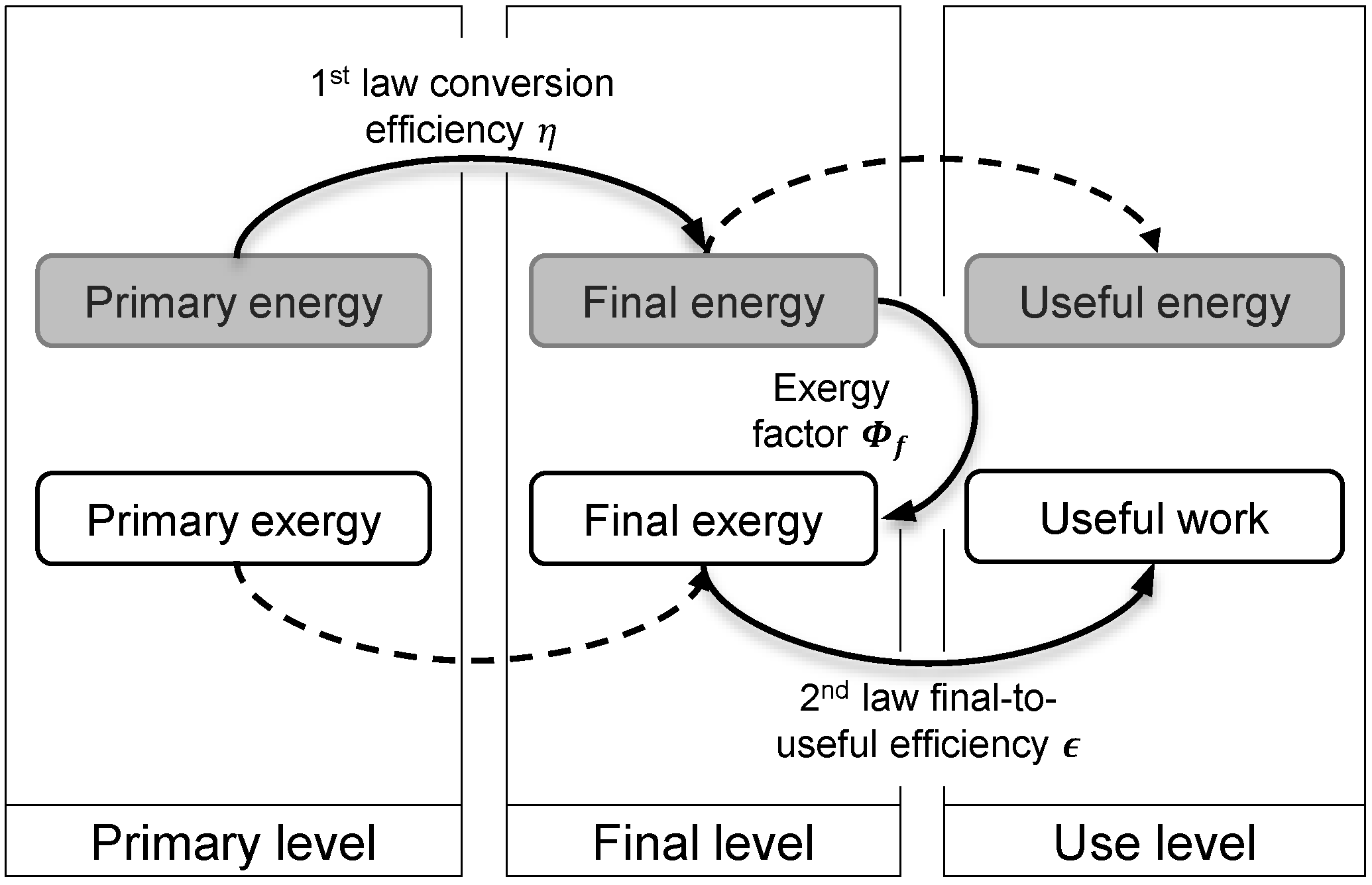
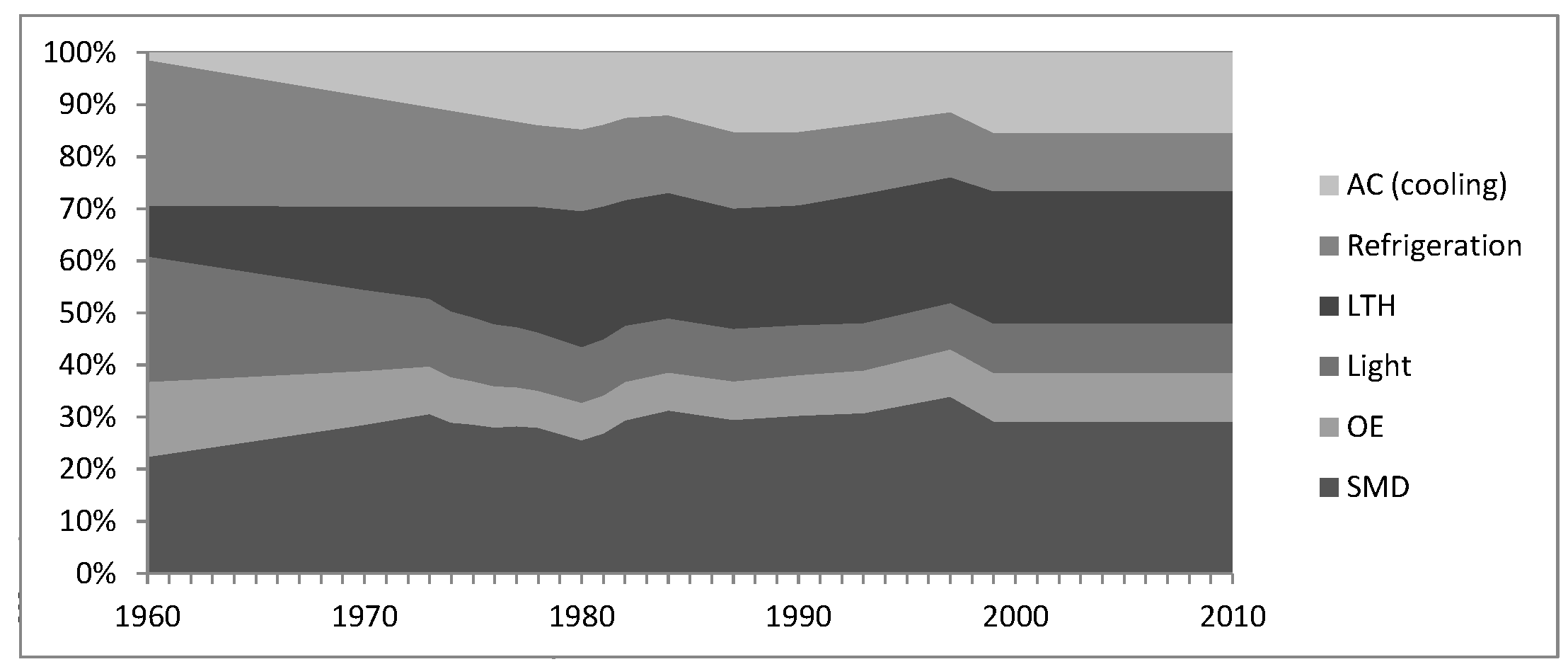
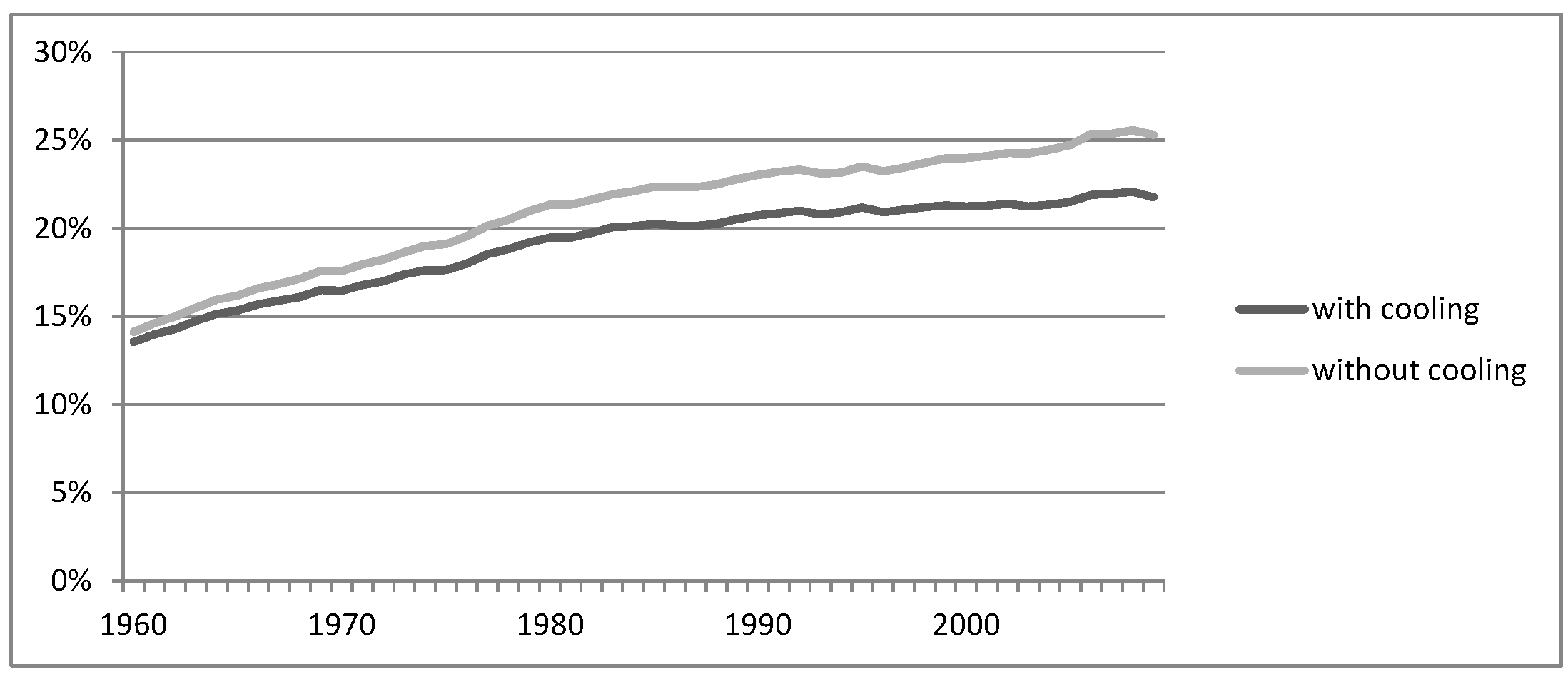
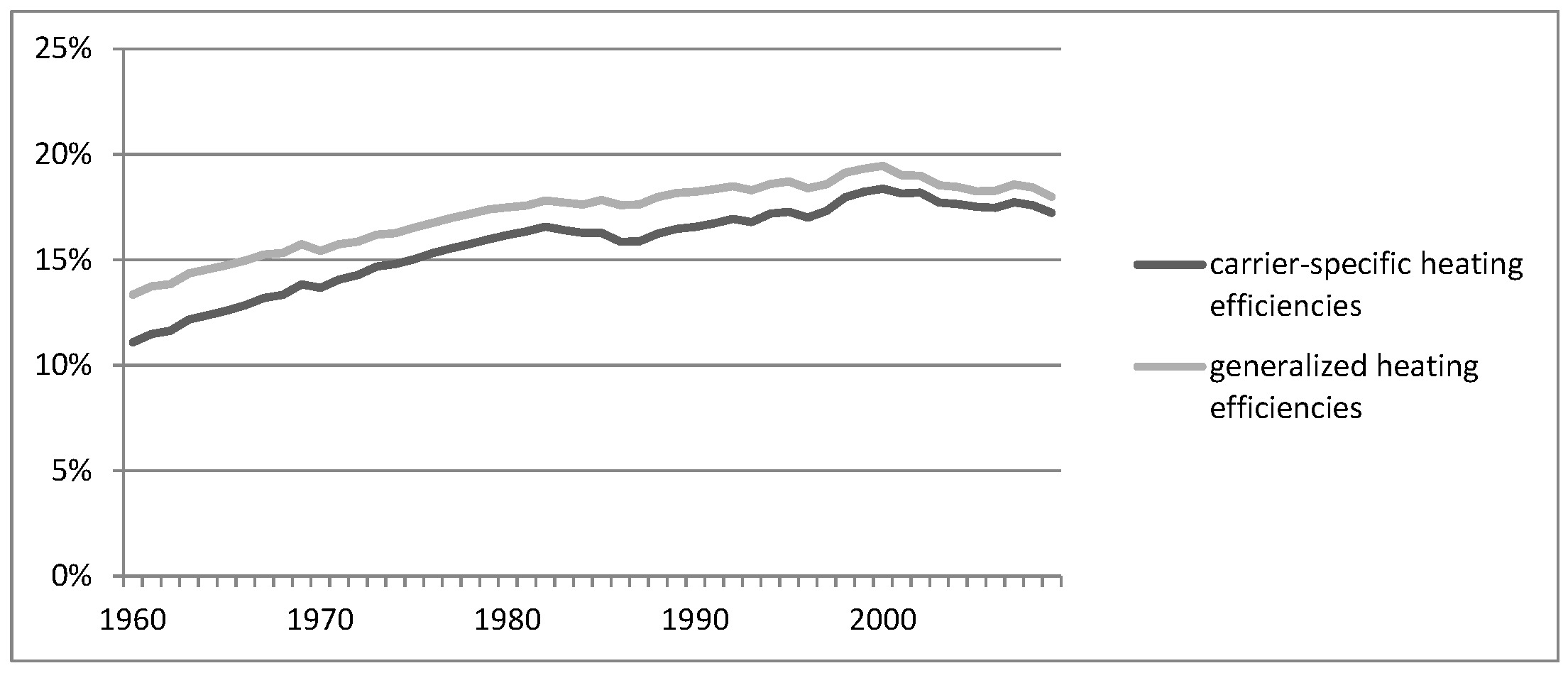

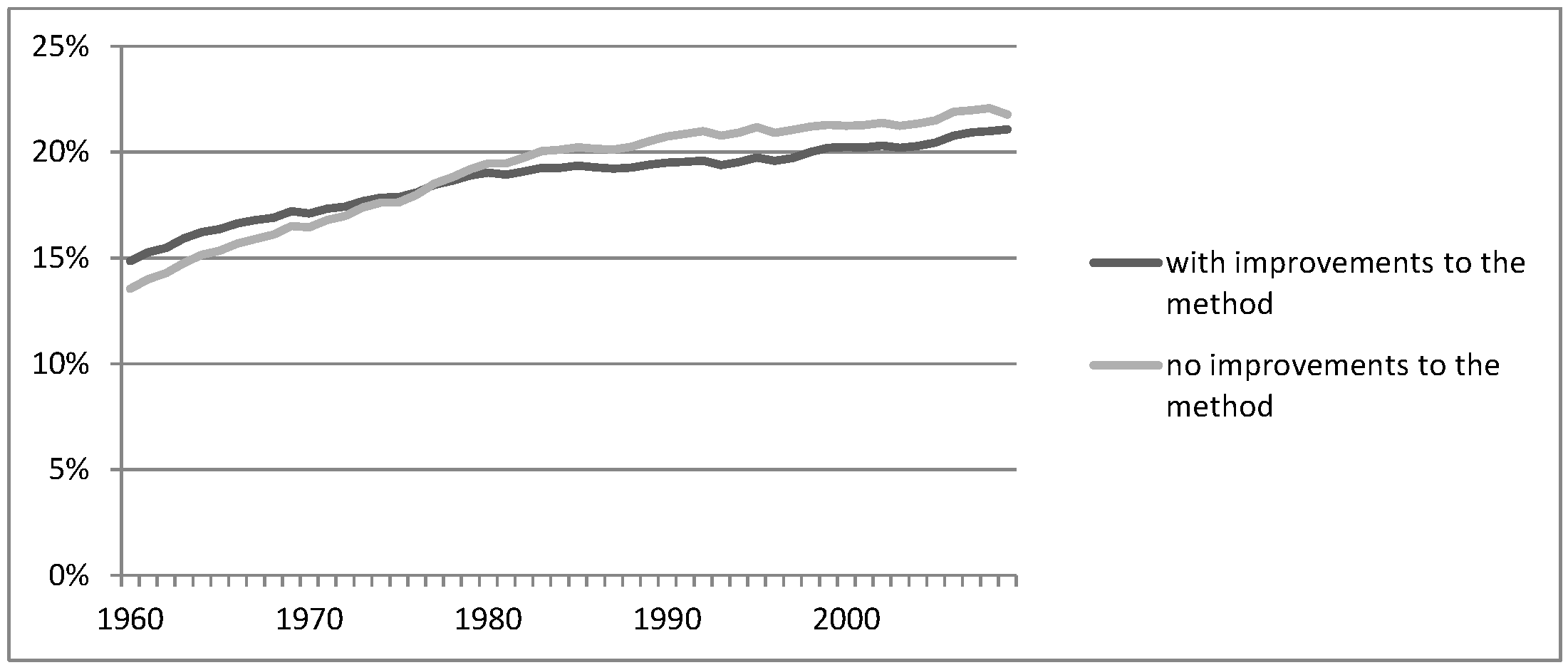
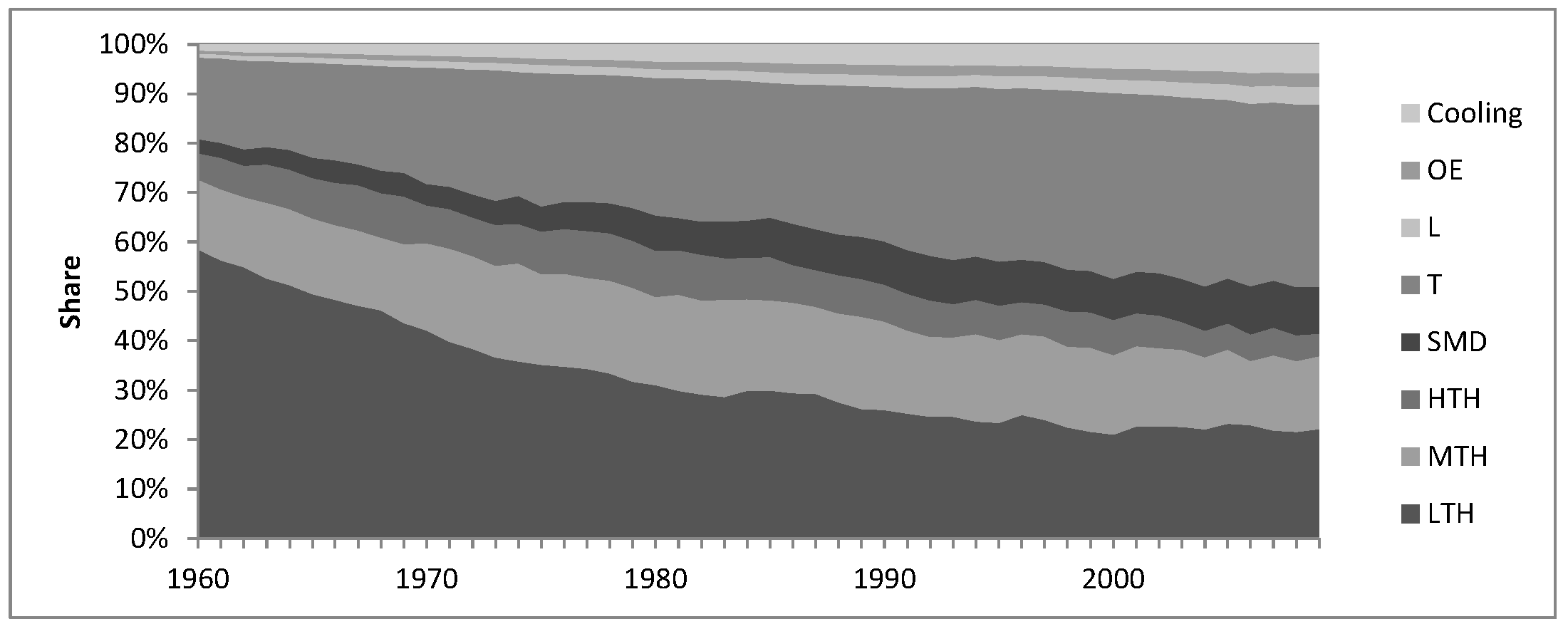
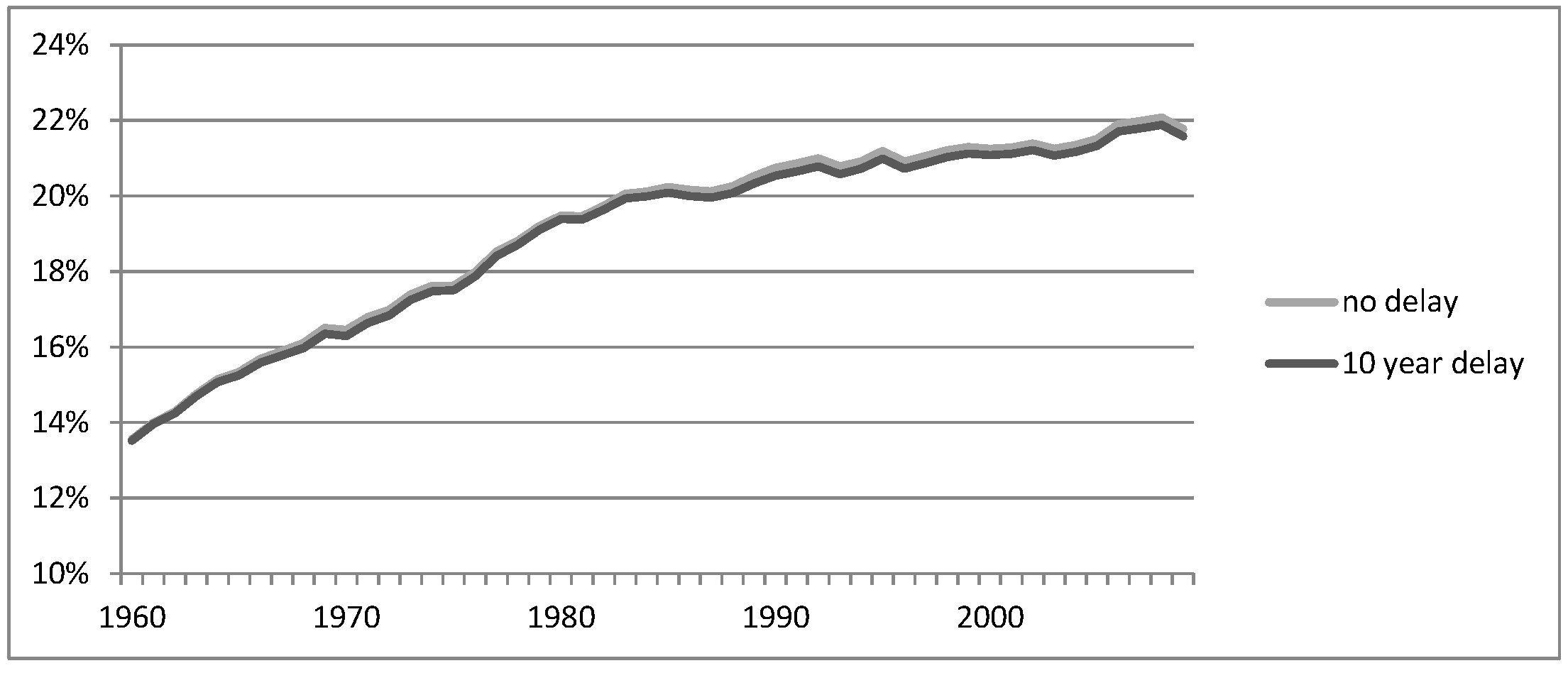

| Energy Carriers | Exergy Factors |
|---|---|
| Coal and coal products | 1.06 |
| Oil products | 1.06 |
| Coke | 1.05 |
| Natural gas | 1.04 |
| Combustible renewables | 1.11 |
| Electricity | 1.00 |
| CHP | 0.60 |
| Aggregated | Disaggregated | |
|---|---|---|
| Heat | High Temperature Heat | (500 C) |
| Medium Temperature Heat | (150 C) | |
| Low Temperature Heat | (80 C) | |
| Stationary | Oil, mechanical drive | |
| Mechanical | Coal, mechanical drive | |
| Drive | Electricity, mechanical drive | |
| Transport | Steam locomotives | |
| Diesel vehicles | ||
| Gasoline/LPG vehicles | ||
| Aviation | ||
| Navigation | ||
| Natural gas vehicles | ||
| Diesel-electric | ||
| Light | ||
| Other electric uses | ||
| Cooling | Space cooling | |
| Refrigeration | ||
| Coefficient | Meaning | Approximate Value |
|---|---|---|
| 1 | Reduction due to stoichiometric deviations | 0.75 |
| 2 | Combustion and cylinder wall’s losses | 0.75 |
| 3 | Friction losses | 0.85 to 0.90 |
| 4 | Partial load | 0.40 to 0.45 |
| 5 | Transmission Losses | 0.75 (automatic) |
| 0.90 (manual) |
| Energy Carrier | Source |
|---|---|
| Diesel | more efficient than gasoline [18,21] |
| Fuel oil | same as gasoline, no and losses |
| Ethanol | less efficient than gasoline |
| Aviation gasoline | [21] |
| Kerosene | [21] |
| Steam locomotives | [22,23] |
| Natural gas | [24] |
| COP and Second Law Efficiency | Cooling | Heating |
|---|---|---|
| COP (real) | ||
| COP (ideal) | ||
| 2nd law |
| Conditioning Mode | Outdoor Temperature (C) | Indoor Temperature (C) |
|---|---|---|
| Heating | 9.8 | 20 |
| Cooling | 28 | 25 |
© 2016 by the authors; licensee MDPI, Basel, Switzerland. This article is an open access article distributed under the terms and conditions of the Creative Commons Attribution (CC-BY) license (http://creativecommons.org/licenses/by/4.0/).
Share and Cite
Palma, M.; Sousa, T.; Guevara, Z. How Much Detail Should We Use to Compute Societal Aggregated Exergy Efficiencies? Energies 2016, 9, 364. https://doi.org/10.3390/en9050364
Palma M, Sousa T, Guevara Z. How Much Detail Should We Use to Compute Societal Aggregated Exergy Efficiencies? Energies. 2016; 9(5):364. https://doi.org/10.3390/en9050364
Chicago/Turabian StylePalma, Miguel, Tânia Sousa, and Zeus Guevara. 2016. "How Much Detail Should We Use to Compute Societal Aggregated Exergy Efficiencies?" Energies 9, no. 5: 364. https://doi.org/10.3390/en9050364
APA StylePalma, M., Sousa, T., & Guevara, Z. (2016). How Much Detail Should We Use to Compute Societal Aggregated Exergy Efficiencies? Energies, 9(5), 364. https://doi.org/10.3390/en9050364






